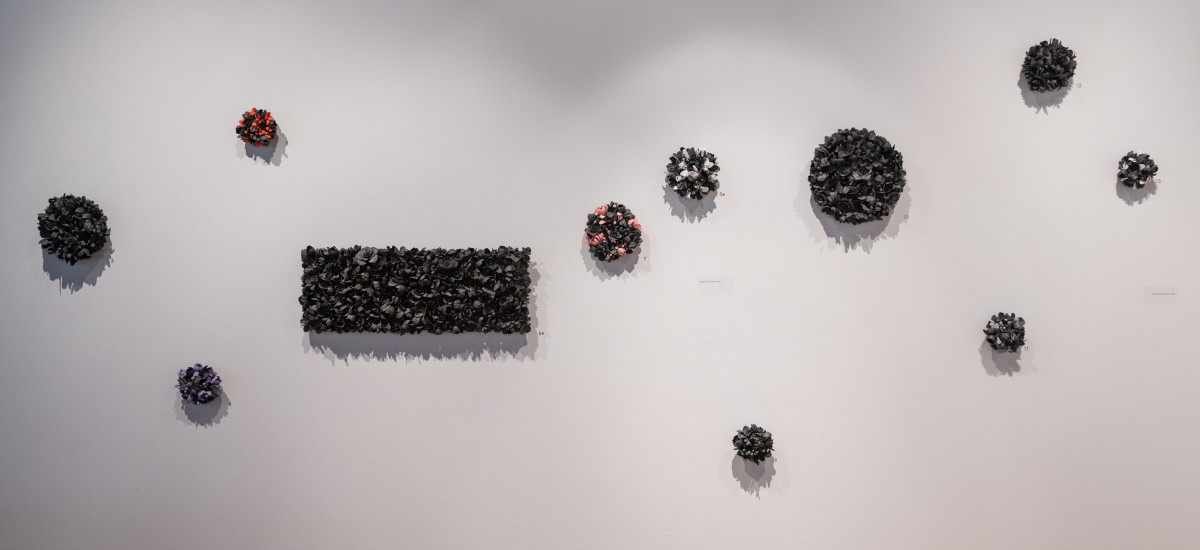While many people gravitate toward bright-colored flowers, in her current work, sculptor and installation artist Rain Harris tends to lean toward more neutral tones, exploring what she calls “the cabinet of curiosity.”
“I kind of like stripping the color from the flowers and giving them a monochromatic black canvas to get an emotional response from the viewers,” she said.
Harris’ work is currently on display in the solo exhibition “Wallflowers” through Aug. 21 on the second floor of the Strohl Art Center. While some of the sculptures are completely black, others contain hints and pops of color.
She has become known for her clay flower sculptures. Harris received her Bachelor of Fine Arts from the Rhode Island School of Design and her Master of Fine Arts from The Ohio State University. She also attended a culinary school, where she focused primarily on pastry making and cake decorating. In her artwork, she often mixes her culinary and artistic backgrounds together to create a refined concoction of intricately detailed and hand-crafted floral designs and pieces.
In her previous work, she created vibrant colored sculptures with vintage floral decals and predominantly flat surfaces, but has since transitioned into creating more neutral, three-dimensional pieces, where the flower itself becomes the main canvas.
Harris often draws inspiration from 17th—century Baroque and Flemish Vanitas Victorian traditions, as well as from her time in Jingdezhen, China. A decade ago, she studied there with Indigenous flower-makers.
That experience ultimately led her to regularly incorporate what she had learned in Jingdezhen into her own artistic practice.
While living in China, she primarily worked with white and translucent clays. After arriving back in the states, however, she was faced with the challenge of finding a new type of material to work with.
She eventually found a black clay at the ceramics store underneath her art studio, and realized that she could use the alternative color to communicate a unique visual language through her work.
“I liked the idea of using black clay, because there’s this whole association of porcelain (and white) with purity, and it sort of took the exact opposite direction,” she said. “I’m really interested in the connotations of black and the kind of associations with it, specifically the Victorian idea of it … and black was a common color that was used.”
During the Victorian era, the trend of mourning jewelry typically included symbols of death, including skulls, skeletons and coffins, which Harris playfully references through her use of flowers. The jewelry, while containing macabre symbols, represented positive messages like the importance of valuing life and memorializing the legacies of the dead.
Judy Barie, the Susan and John Turben Director of Chautauqua School of Visual Arts Galleries and curator of “Wallflowers,” said one of the biggest reasons she gravitated toward Harris’ work upon first glance was because a viewer doesn’t normally envision or associate the color black with flowers; Harris offers viewers a new perspective.
Her artwork often utilizes resin, a plant-based substance typically transformed into paints and coatings. The material parallels environmental reactions and transformations that directly result from human impressions and footprints on the planet. Harris oftens balances contrasting elements, like nature and artificiality, with organic and more industrial, man-made components.
“I’m really interested in the two sides of nature, in how we sculpt and manicure nature to make it prim and proper,” Harris said. “I’m also interested in the exact opposite of what happens when nature goes wild and rebels.”
Harris likes exploring the theme of nature’s reckoning and intervention on humans. She often references this through the imagery of foliage and plants becoming “caught in an ice storm,” visually represented through the resin spreading over the flower in her work.
Although humans often attempt to manipulate, control or forecast predictions over their natural environments, Harris said nature is ultimately unpredictable and operates at its own will.
“I’m interested in what happens when nature comes up against you, the kind of unpredictable parts of weather,” she said. “When you think about an ice storm, the flowers and plants that always get caught are the non-native plants that are brought to a place, forced to grow in an environment.”
Harris said that she likes to incorporate environmental imagery into her work.
“I really love imagery,” she said. “The imagery of ice, I’m definitely really attracted to that. I kind of consider it to be this embalmed everbloom — this moment of life and death together.”





